Today we will be talking about the “New Pension Scheme” Launched by Govt. of India.
What is NPS?
Its a pension system recently launched by Govt of India from 1st April, 2009.. You can regularly invest your money in this and get a lump sum at your retirement and a fixed monthly income for the lifetime . It will work almost the same way as Private Pension Schemes.

Until now the pension schemes was available to Govt employees and employees of Big companies who has Provident fund facility. Any other person had to go with Private Pension schemes provided by Insurance Companies. IT as not a govt scheme for common person, With NPS now its a common person gateway to Pension Schemes.
Read previous post which was a guest post by Nooresh Merani on “How does a day trader looks like”Features
– No upper limit of Investment
– Minimum limit of 6,000 per year (Rs.500 per month).
– Annual Fees of .00009% (90 paisa for Rs.10,000) for Managing the fund.
– Tax benefit under sec 80C.
– Any Indian citizen between 18 and 55 years can invest in NPS.
Read other details below.
NPS Bodies
– Regulator : The one who will regulate the NPS System .
– Fund Managers : Who will invest the money
– Point of Presence : Responsible for Sales and Marketing .
– Central Record Keeping Agency : Responsible for all the document Keeping work (Record Keeper)
Lets see each of them In detail now .
Who will Regulate NPS?
PFRDA(Pension Fund Regulatory and Development Authority) will monitor and regulate all the activities under NPS. It checks how your money in invested and makes sure that the fund managers are following the rules and guidelines.
Its just like “SEBI for Stock Market” .
Who are the Fund Managers?
There will be 6 Fund houses appointed by Government to manage the funds under NPS. You can choose any one of them to be your Fund Managers. They are :
1. SBI Pension Funds Private Limited.
2. UTI Retirement Solutions Limited.
3. ICICI Prudential Pension Funds Management Company Limited.
4. Religare Pension Fund Limited.
5. IDFC Pension Funds Management Company Limited.
6. Kotak Mahindra Pension Fund Limited.
They will take all the decisions of where the money received under NPS should be invested in the best possible way considering all the rules and regulations set by PFRDA.
Watch this video to know about national pension scheme:
Who are Point of Presence?
The following entities have been approved by PFRDA for appointment as Points of Presence (POPs) under the New Pension System for all citizens other than Government employees covered under NPS.
1. Allahabad Bank
2. Axis Bank Ltd
3. Bajaj Allianz General Insurance Co Ltd
4. Central Bank of India
5. Citibank N.A
6. Computer Age Management Services Private Limited
7. ICICI Bank Ltd
8. IDBI Bank Ltd
9. IL&FS Securities Services Ltd
10. Kotak Mahindra Bank Limited
11. LIC of India
12. Oriental Bank of Commerce
13. Reliance Capital Ltd
14. State Bank of Bikaner & Jaipur
15. State Bank of Hyderabad
16. State Bank of India
17. State Bank of Indore
18. State Bank of Mysore
19. State Bank of Patiala
20. State Bank of Travancore
21. The South Indian Bank Ltd
22. Union Bank of India
23. UTI Asset Management Company Ltd
Who will be the CRA?
As per the website of PFRDA there is a Contact of negotiation is underway and NSDL is expected to be appointed as the CRA. there were other bodies too who wanted to be CRA, but the most suitable of all is CSDL. You can see them as the back office for maintaining records, administration and customer service functions.
What are the Steps of Investment?
- Visit a point of presence (PoP), fill up the prescribed form with the required documents.
- Once registered, CRA will send you a Permanent Retirement Account Number (PRAN). This will be unique to every person.
- Select your Amount and Investment Option.
Investment Options and Structure
Structure wise they are very similar to ULIP’s or ULPP’s from Investment Point of View . You have different kind of funds options with different exposure to –
– Equity Instruments
– Corporate Debt
– Fixed Income Instruments
– Govt Securities.
Different Options
– Risky option : The higher allocation in this option will be in Equity. To decrease the risk, Equity Investment is allowed only to invest in Index funds which tracks Sensex or Nifty. Also the equity exposure is caped at 50%.
– Moderate : IN this options Main exposure would be Corporate debt and Fixed income securities with some exposure in Equity and Govt securities. It will be moderately risky and rewarding.
– Safe : In this option mainly the investment will be done in Govt securities, and very little will be invested in Equity.
There will be a Default option , under which the allocation will be decided as per your age, where Equity Allocation will be high in the start and then it will come down as your age increases . You can also decide your own asset allocation as per your Risk appetite
Cost
There are different kind of Costs in NPS.
– Fund management charges of .0009% per Annam, which is excellent if compared to ULPP’s or Mutual funds charges .
– Annual Maintenance charges of Rs.350 and Rs.10 per transaction to CRA (soon, it will be Rs.280 per year, Rs.6 for per transaction).
– Rs.40 for registration with PoP and Rs.20 per transaction with them.
– There are other small costs too, lets leave it for now.
Taxation Issue
Sadly, As per the current law, the amount received at the end from NPS would be taxable, PFRDA is trying hard with govt to exempt the tax. You will get the 80C benefits on the amount invested in NPS.
UPDATE May 3, 2009
“Under following circumstances your account may be closed before attaining retirement age?
– death
– account value reduces to zero
– change in citizenship status.
Thanks to Viral for bringing up this point
Read NPS FAQ here
Conclusion
As per my views, Its a good initiative from Govt to introduce a Pension Scheme which will give common people a chance to invest in Pension schemes which is from Govt.
One important thing to understand and note is that Even though its a pension scheme, the returns are not guaranteed. It can vary drastically depending on your asset allocation and how you choose the fund options.
Other Negative point at this point is that the amount received at the end would be taxable which can have adverse affect on the return potential. But I am sure soon govt will make the final amount received non-taxable.
Currently I don’t rate it at par with PPF or EPF. At this point it would be wise to invest money in this if you have any money left over after your PPF and EPF contribution. Waiting for some more time before taking a call on this would be worthwile . Overall NPS passes 🙂
Question for you
– Are you personally impressed by NPS and will you invest in NPS?
– What else govt can make changes in NPS to make it attractive to you?
Previous Post : Nooresh Merani Guest post on How does a Day trader looks like?
– Subscribe to jagoinvestor google groups
– Follow me on twitter
– Please leave your Comments/suggestions/disagreements .

